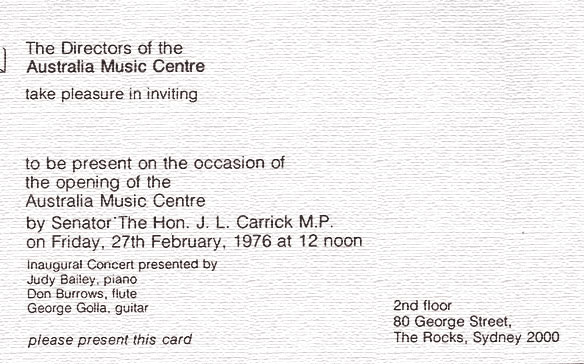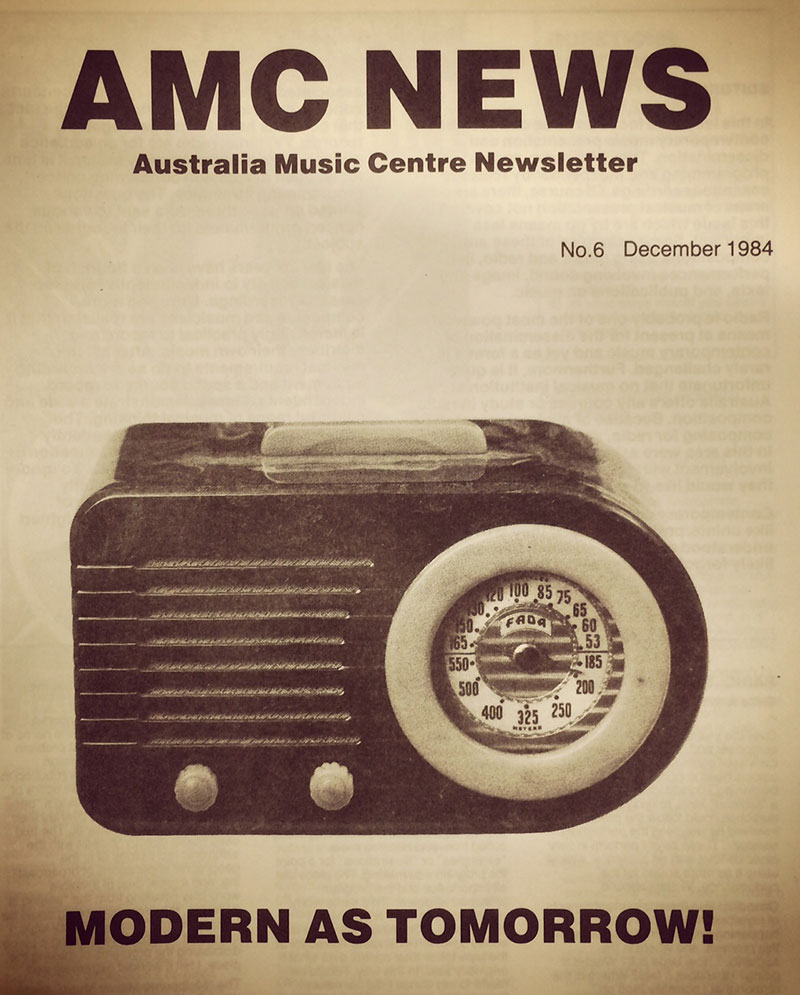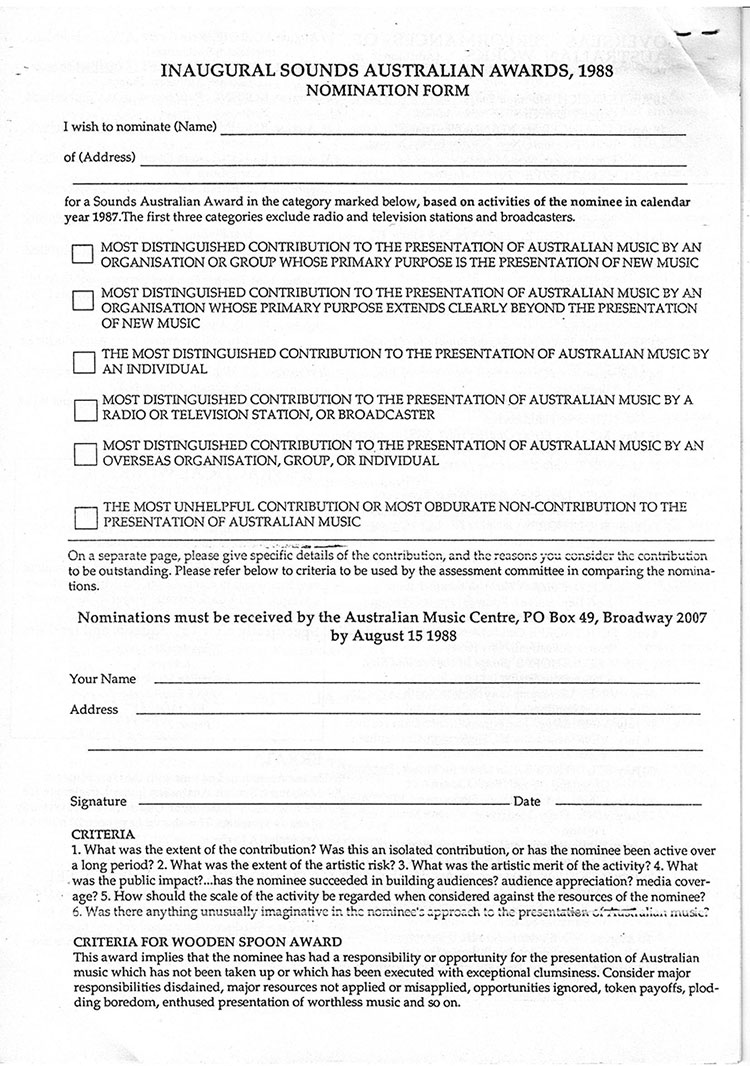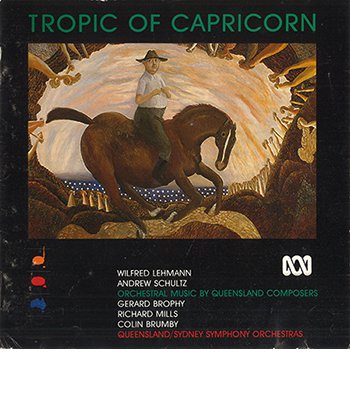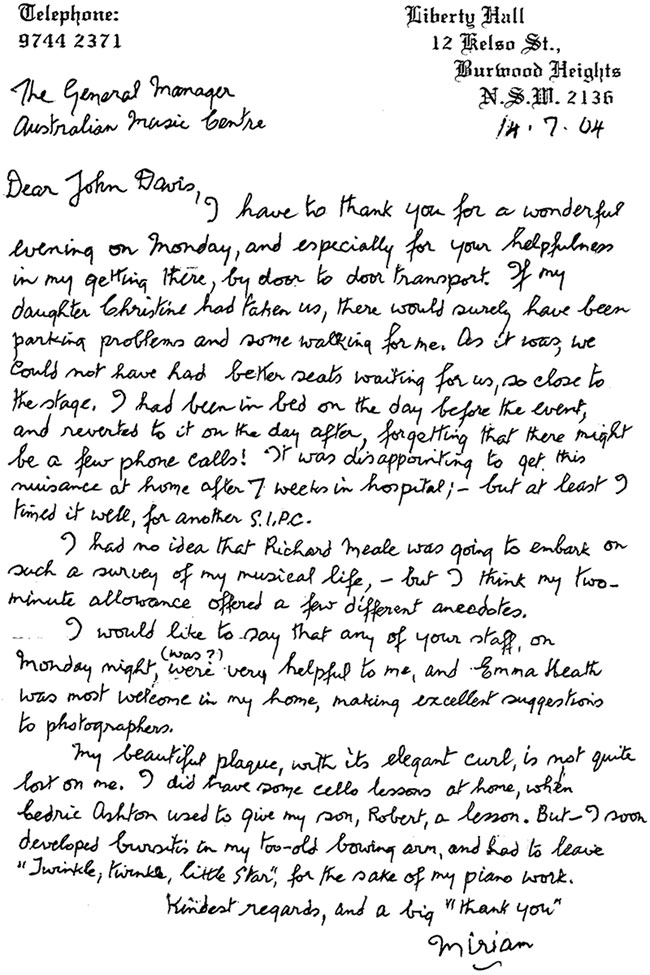Australian Music Centre - the first 45 years
'Australia Music Centre' opened its doors to the public on 27 February 1976 - by this date the Centre had already been operating at its first, spacious premises at The Rocks, Sydney, for several months under the leadership of the AMC's first director, James Murdoch. The first steps had, in fact, been taken as early as August 1974, when the foundation document was signed by five signatories.
We've been piecing our history together in the timeline below. Click the images for a larger view - you can also view them as a slideshow by clicking the small arrow symbols, or by swiping if you're using a touch screen. Any additions, images, and, of course, corrections to dates, names and places of the timeline are very gratefully received - please contact us.
With the establishment of the Australia Council, funds for a music centre become available. James Murdoch is appointed the AMC's founding National Director.
The Articles of Association for the Australia Music Centre are signed on 13 August 1974. Signatories are John Sturman (Chair), John Day,
Prudence Neidorf, James Penberthy and Nathan Waks.
The Australia Music Centre starts operations in September 1975 in central Sydney at 80 George St, opposite the Sydney Opera House. While not yet open to the general public, the centre is accepted as a member of the international associations IAMIC and IAML.
In the first months, the centre becomes a venue for launches and lunches, with a steady number of visitors. Among the first visiting international composers is Luciano Berio (in October 1975). James Murdoch later writes about the establishing of the centre in his article 'Euphoric Days' in the Sounds Australian issue No. 55 (2000).
Read also Vincent Plush's article 'The Glamorous Early Days' (Resonate).
The AMC opens its doors to the public at noon on 27 February 1976, officially launched by Senator the Hon. J L Carrick MP. An inaugural concert features Judy Bailey (piano), Don Burrows (flute) and George Golla (guitar).
The centre's spacious (4,500 square feet) facilities include a library, a conference room, space for research and listening to recordings and radio, and a photocopying service. Six large paintings by Charles Blackman are hung on the walls 'on permanent loan'. Many book launches and receptions for international visitors are organised during the first 18 months of operation. Read an article in the APRA Journal in January 1976 and a report in the Sydney Morning Herald (27 February 1976).
A week of free 'carpet concerts' follows the opening.
Generous media coverage has some negative consequences - thieves break into the centre in March, cause damage and steal tape recorders (Sunday Telegraph, 21 March 1976)
Peggy Glanville-Hicks is appointed the AMC's Consultant for Asian Music, The Age reports on 20 September 1976.
The AMC turns 1. A catalogue of works by living Australian composers has been published, a catalogue of dramatic and film music is in preparation, and 'a national network of branches' is being planned, reports the Saturday Evening Mercury on 21 May 1977.
Numerous live music events are organised at the AMC, among these a concert by the Larrikins.
Activities during the first few years of the centre's operation include establishing a library and an information service and a newsletter AMC News. The centre manages the Australia Council/APRA parts-copying scheme. Initially all composers are invited to include their scores in the centre's collection without restriction.
Pictured right: James Murdoch with Peggy Glanville-Hicks. One of Peggy's projects at the AMC was to commission seven composers (four Australians - Banks, Sculthorpe, Plush, Edwards) to write pieces related to the wooden sculptures by her artist friend Pam Boden (read more in Vincent Plush's article on Resonate). She also organised lunches for her famous American friends at the AMC.
AMC has had three logos over the course of its 40-year history. The very first logo, used from the very beginning, was a black and white, modernist logo. In 1987 it was replaced by one drawn by the famous Australian designer Ken Cato (see 1987 below). AMC's current logo has been in use since 2009.

1980 sees the first instalment of the Young Composers' Summer School, subsequently the National Orchestral Composers School (NOCS), later named the Australian Composers Orchestral Forum (ACOF). This important program runs until 2004 - first participants are Elena Kats-Chernin, Graeme Koehne, Graeme Skinner, Robert Smallwood, Carl Vine, Simon Wade and David Worrall. Over the course of 25 years, the ACOF - realised in cooperation with Symphony Australia, with funding from the Australia Council - is hosted by almost all Australian professional orchestras.
Despite outward appearances, the centre's funding is not secure. The AMC's services are not bringing in significant income, and its continued funding from the public purse is not guaranteed.
Martin Buzacott worked at the AMC Library from 1978 until the early 1980s. He writes: 'I encountered the first icy blast on an ABC News report one morning, probably around 1981, announcing that the Music Centre was now closed, just as I was about to go to work for the day. Fortunately the Centre survived that false alarm, but from then on we all knew that its days were numbered... If the AMC was to survive beyond the early 1980s, less colourful, more sober-sided administrators had to take over in order to appease the government funding agencies. We scattered, James to his beloved Bali, me into surely the best-managed music organisation in Australian history, Musica Viva, and others among us drifted off to other professions.' Read Martin's article 'The job I got thanks to a green velvet suit' on Resonate.
The annual report for 1981-1982 states: 'the Centre remained largely dormant during 1981. In order that the Centre did not ever close its doors, it was arranged that the executive director of Australian Music Marketing Services (AMMS) - Joan Bona - should occupy space in the Centre. She acted as agent of the Centre.'
A librarian is hired in April 1982 and another staff member a little bit later, and gradually the AMC resumes operations. The Board determines that the role of the Centre is to 'concentrate its activities on the collection and dissemination of information on all forms of Australian music'.
The Centre re-opens to the public on 3 September 1982, with Joan Bona as administrator.
The AMC receives a grant from the Music Board for producing four LPs of 'Australian contemporary serious music'. Planning starts for the centre's own record label.
The AMC Newsletter July 1983 reports plans to make the centre 'a truly national organisation' and gives details of AMC contacts in four states. 'The AMC receives funding from the Music Board of the Australia Council on a national basis, and we are, therefore, concerned that the resources we have, and the promotional support we can offer, should be available Australia wide. We are well aware of the problems that come from being Sydney-based, and have been exploring ways to overcome this.'
'Modern as tomorrow!', proudly declares the cover of the AMC News issue no. 6 (December 1984), guest edited by Richard Vella. A decision has been made to start developing the newsletter into 'a forum for discussion about composition and issues pertaining to new music in Australia'. The newsletter contains an article titled 'Radio: the Blind Spot' by Ernie Althoff, Carl Vine's views about programming for Flederman ('The objective is quite simple: to air recent Australian music complemented by an appropriate selection of overseas contemporary music.'), and John Crawford's views about programming for radio, as well as interviews with Nigel Butterley and Virginia Madsen, among others. Empty space in the pages of the newsletter has been filled with vintage ads for concerts, artists and radio programs.
Frank Maietta follows Joan Bona as the AMC's administrator - Maietta with his staff in 1984.
The double issue of AMC News (No. 7-8, April 1985) has extensive coverage of the role of the ABC in Australian music: 'The material presented here on the ABC is significant because to our knowledge it is the first extensive published statement on the ABC's policies for the performance and broadcasting of contemporary Australian music. The picture presented here is depressing in the extreme: indisputably, living Australian composers are being sold short by the ABC. While the past is grim, unless changes are made, the future prospects for composers will not improve.'
1985The AMC is busy compiling directories of Australian music organisations and Australian composers - for the latter, a form is circulated, with the object to 'list all Australian composers, detailing contact address, telephone number, year of birth, and a sentence or two on each composer's current work/interests'.
The official name of the AMC is changed to Australian Music Centre. The centre moves to new premises on Smail St, Ultimo, in June 1986.
Difficulties in securing funding for the centre's activities provide the backdrop for the year, with this plea by the AMC's Chairperson, Janet Donald, published in the March issue of AMC News.
'The AMC Recording Project' is announced, with the aim of establishing a comprehensive collection of sound recordings of works by Australian composers, and providing dubbing services. AMC is also hoping to make its own recordings of performances. AMC's recording facilities are housed in Melbourne, with a part-time technical officer based there for the project.

Richard Letts becomes the executive director and continues until mid-1993. Under his watch, the AMC gets a record label, Vox Australis, and a magazine Sounds Australian Journal. The AMC also starts publishing educational resource kits.
AMC releases its very first record in collaboration with the ABC, a CD of Roger Smalley's music (including Piano Concerto, the recommended work in the annual UNESCO Rostrum of Composers in 1987). The November issue of the AMC's monthly newsletter Update proudly announces the release: 'It's a COMPACT DISC!'. The same Update explains the Centre's new selective collection policy and its two tiers of artist representation.
In 1987, an International Promotions Unit, led by Vincent Plush, is established to promote the performance of Australian music overseas during the Australian Bicentenary. The loan of a photocopier makes it 'possible for the AMC to seriously enter into the provision of facsimile scores' (AMC Update, July 1987). A grant is secured to commission a new logo for the centre from Ken Cato, the designer of many iconic Australian logos (e.g. the Commonwealth Bank and the Network Seven logos).
The Board brainstorms a new name for the AMC's journal AMC News in their meeting on 31 August and, at the suggestion of Judy Gunson, adopts the name Sounds Australian.
First held in 1988, the annual Music Awards (first Sounds Australian Awards, later Classical Music Awards, and finally Art Music Awards), are established to acknowledge achievements by Australia's artists and others involved in the presentation of Australian music. Nominations are sought in six categories, including 'The Most Unhelpful Contribution or Most Obdurate Non-Contribution to the Presentation of Australian Music'.
The Australian National Composers' Conference is organised in Sydney - the proceedings from this conference and subsequent ones in Brisbane and Melbourne are later published by the Centre in three volumes of Composer Speaks books.
The second CD released by the AMC features works by Queensland composers Wilfred Lehmann, Andrew Schultz, Gerard Brophy, Richard Mills and Colin Brumby.
The Aspen Music Festival in Colorado has an Australian theme as a result of the efforts of the International Promotions Unit, with works by numerous Australian composers performed and three composers in residence (Peter Sculthorpe, Vincent Plush and Andrew Ford).
Collections of Australian music are also established at Australian Embassies in London and Paris.
Trading name 'Sounds Australian' is formally adopted at the end of 1989 and used by the AMC for the next decade.
Autumn 1989 issue of the Sounds Australian magazine (No. 21) comes out with the special theme 'The Woman Composer'. The issue also gives coverage to an ongoing campaign to increase Australian content in ABC-FM's programs - this has been a hot topic since 1985, with musicologist Richard Toop as a leading critic of a programming policy that he describes as 'A 24-hour Muzak system for an Anglo-Saxon Retirement Village'. The ABC eventually brings in targets for the percentage of time to be given to Australian compositions and performances.
Another hot topic was introduced on the Letters to the Editor pages in the Winter 1989 issue of the Sounds Australian Journal in the form of three manifestos by an anonymous entity calling themselves 'the 'Adelaide Pastoral Company'. APCo's true identity/identities remain a mystery, but their critique of new complexity (initially Brian Ferneyhough's music) was the launch of the so-called 'style wars', fought, sometimes in jest but much of the time extremely seriously, on the pages of the Journal and the AMC's Update in 1989-1991, and the Australian New Music Conference in Brisbane in August 1990.
The Australian New Music Conference - formerly the Composers' Conference - is held in Brisbane in August, with 82 delegates attending.
Sounds Australian Journal devotes its issue No. 27, guest edited by Belinda Webster, to expatriate composers and performers.
Brenton Broadstock scores a hat trick at 1990 Sounds Australian Awards: his Symphony No. 2 Stars in a dark night wins awards for the Best Orchestral Work and the Best Work by a Victorian Composer, and a performance by the MSO of the same work is ranked best in Victoria as well as nationally.
Peggy Glanville-Hicks dies on 29 December.
The publishing of educational materials gets a boost in the form of a grant from the Commonwealth Department of Education: the first Sounds Australian Education Resource Kits are published in 1991.
In 1991, the AMC relocates to Argyle Centre, Playfair Street, in The Rocks.
Sounds Australian issue No. 30, guest edited by Andrew Schultz, comes out with the theme 'Appropriation - tradition - borrowing - theft'. The Summer issue of 1991-92 (No. 32), guest edited by Roger Dean, focuses on improvisation.
The inaugural Paul Lowin Awards are announced in August 1991, with Julian Yu's Hsiang-Wen winning the Orchestral Prize of $45,000, and Stephen Cronin's House Songs the winner of the $20,000 Song Cycle Prize. Nigel Butterley's $50,000 'Keating' fellowship also makes the news in 1991.
'For some, 1992 will be remembered as the year in which the Australia Council, after many years of increasing support to the Music Centre, cuts its annual grant by 16%. Yet it is a measure of the resilience and determination of the organisation that it has proceeded undaunted and with renewed determination to pursue its important mission', writes the Chair of the AMC's Board, Andrew Schultz, in his annual report for the AMC's AGM (Update June 1993). Staff, activities and programs are all affected as a result of the cuts.
The Australian National Composers' Conference takes place in Melbourne.
Warren Burt guest-edits the Sounds Australian issue No. 33 (Autumn 1992) 'Postmodernism: What is it???'. In issue No. 34, Ian Shanahan and Chris Dench collect a series of 'credos' by 34 composers under the header 'An Emotional Geography of Australian Composition' (link to pdf, 3MB). A second volume of these follows in the Winter 1995 edition (No. 46).
The AMC gets a website and a basic online catalogue. 'AMC Online!' declares the Update in October 1993, with instructions how to access the AMC's 'computer bulletin board'.
Funding cuts are affecting operations, and Sounds Australian Awards do not proceed in 1993-1995. Read Ken Tribe's letter criticising the cuts in the Sounds Australian Journal no. 37 (Autumn 1993). The same 'Open Forum' pages include an outpouring of anagrams by Martin Wesley-Smith, inspired by the words 'Sounds Australian' .
The AMC relocates to purpose-fitted space in Argyle Stores. A standalone Sounds Australian retail outlet operates in The Rocks from 1993 to 1997.
Sounds Australian issue No. 38 (Winter 1993) features articles about Liza Lim's The Oresteia, premiered by ELISION, directed by Barrie Kosky, in Melbourne in May 1993.
AMC re-establishes the Australian ISCM Section, previously administered by the Sydney University Music Department.
Sounds Australian Journal's Summer issue (no. 40, 1993) comes out with the theme 'The Woman's Issue', guest edited by Sally Macarthur and Susan Erickson, with articles by Macarthur, Erickson, Kirsty Beilharz, Anne Boyd, Mary Mageau, Moya Henderson, Sarah Hopkins, Linda Kouvaras, and others. The articles in this issue provoke several letters to the editor, published on the 'Open Forum' page of the following issue of the Journal.
The discussion of arts funding continues in the Sounds Australian Journal issue No. 43 (Spring 1994).
Julian Yu's Three Symphonic Poems wins the Paul Lowin Orchestral Prize. The Song Cycle Prize goes to Bright Tracks by Brenton Broadstock.
John Davis becomes the General Manager of the Centre in 1995, after Catherine Brown-Watt (1993-1995).
Sound art and noise are themes for the Sounds Australian Journal No. 45 (Autumn 1995), guest edited by Rebecca Coyle, with articles by Richard Vella, Julian Knowles, Carolyn Connors, Andrew McLennan, Ernie Althoff, Ros Bandt, and others.
A second volume (link to pdf, 3MB) of composer credos under the header 'An Emotional Geography of Australian Composition II', edited by Ian Shanahan and Chris Dench, is published in the Winter 1995 edition of the Sounds Australian Journal (No. 46).
The yearly Awards are resurrected and restructured to reflect the diversity of activity in the new music scene. Elena Kats-Chernin's Cadences, deviations and Scarlatti wins the Award for the Best Composition by an Australian composer. The Award for the Best Performance of an Australian Composition goes to ELISION Ensemble for their performance of Funk by Chris Dench. Musica Viva in Schools wins the Award for Outstanding Contribution to Australian Music in Education.

Caeli enarrant by George Lentz wins the Paul Lowin Orchestral Prize. The Song Cycle Prize goes to Martin Wesley-smith's opera Quito.
Robert Hughes is presented with the Classical Music Award for Long-Term Contribution to the Advancement of Australian Music, and Colin Bright wins the Award for Best Composition for The Wild Boys. Marshall McGuire wins the Award for Outstanding Contribution by an Individual.
The AMC's retail operations are once more located in the same space as the Centre's Library and office in the Argyle Stores, as suggested by an AusIndustry consultancy carried out on the AMC's activities in the beginning of 1998.
AMC publishes the book Australia: Exploring the Musical Landscape. Read an article from the book: "Living Songs - Music, Law and Culture in Aboriginal Australia" (by Jo Dyer).
Cellist David Pereira wins the Classical Music Award for the Best Performance of an Australian composition for the second year running. The Award for the Best Composition goes to Paul Sarcich's Matters arising.
In 1999, the Australian Music Centre starts to present the Paul Lowin Prizes in collaboration with Perpetual Trustee Company. The Paul Lowin Orchestral Prize goes to Michael Smetanin for his work The Shape of Things to Pass; the Song Cycle Prize goes to Raffaele Marcellino for Canticle.
The AMC hosts the annual conference of International Association of Music Information Centres IAMIC, with delegates from all over the world (pictured left - larger view), and relaunches its website, now with an improved, searchable catalogue and a more sleek graphic design. 1999 new releases include the book Musics and Feminisms, edited by Sally Macarthur.
Murchitt: a daydream by Lawrence Whiffin wins the Classical Music Award for the Best Composition.
Some invaluable advice on stage etiquette for composers was included in the AMC Update issue no. 111, August-September 1999.
From July 2000, composers are able to submit their scores to the AMC Library in digital format as an alternative to hard copy. The AMC conducts a survey and finds out that 50% of members would like to receive their AMC Updates electronically.
The first Performing Australian Music Competition takes place in London, launched as part of the Australia Music Week in 2000 and culminating on Federation day on 9 May 2001. PAMC is run in association with the Australian Music Centre and the Australian High Commission in London. Six finalists are chosen from over 70 contestants from 20 countries performing works by 46 Australian composers. First Prize goes to the South African marimba player Magdalena de Vries. Read an interview with the woman behind PAMC, Penelope Thwaites.
At the end of the year, the AMC moves again - this time to The Arts Exchange at 10 Hickson Road, The Rocks, adjacent to original location of the Centre at 80 George Street. Before the official move, the Centre makes use of the empty office space by organising the 2000 Awards event at Hickson Road. Brett Dean's Beggars and Angels wins the Award for the Best Composition.
In the 'Publish and be damned' print publishing issue of the Sounds Australian Journal No. 57 (2001), the AMC's CEO John Davis reports that the AMC is preparing itself for online distribution of unpublished scores. 'We are beginning a process of gradually digitising our collection, something that other Music Information Centres around the world are also considering.' The following Sounds Australian issue No. 58 focuses on digital publishing. (The digitisation of the main part of the AMC's collection was finally completed with additional funding from the Federal Government in 2013-2015. More details about the Digitisation Project.)
The 2001 Australian Music Centre Awards and the Paul Lowin Prizes are announced at a joint ceremony at the Customs House, Sydney, on 22 October. Kenneth Tribe is recognised with the Award for Long-Term Contribution to the Advancement of Australian Music, and Amanda Wojtowicz receives a special Award for Outstanding Contribution to the Advancement of Australian Music for her tenure as Chair of the AMC Board of Directors in 1996-2000. Award for Best Composition goes to Gordon Kerry for Vigil.
Lowin prizes are awarded to Nigel Butterley for Spell of Creation (Orchestral Prize) and Brett Dean for Winter Songs (Song Cycle Prize).
The AMC and APRA join forces in presenting the yearly Classical Music Awards. Liza Lim's ritual street opera Yuè lìng jié wins the Award for the Best Composition.
The number of Represented composers reaches 400. AMC starts assigning ISMNs to newly received scores and sets of parts in the beginning of 2002 - the ISMN (International Standard Music Number) system has only just become fully operational in Australia in December 2001.
'Australia Ad Lib' issue of the Sounds Australian Journal (No. 59, 2002) focuses on sound art, with contributions by Jon Rose, Colin Bright, Jim Denley, Tos Mahoney, Cathy Peters, Robyn Ravlich, Hollis Taylor, and others.
A series of composer seminars are organised in the AMC's premises in collaboration with the Sydney Symphony Orchestra.
MODART composer development program is established in partnership with The Song Company - a call for 'ideas, sketches or scores' for a cappella vocal ensemble has been announced in the AMC Update August-October 2002, and an impressive 21 participants are chosen to work with The Song Company, Roland Peelman and composer in residence Raffaele Marcellino.
Also established in 2003 is the Trans-Tasman Composer Exchange Program, with the NZ composer Gareth Farr as the first resident.
The inaugural National Keys Competition takes place in Brisbane, designed to promote Australian composition. 180 Australian works are performed by participating amateur pianists, among them 21 new piano works written for the competition.
Richard Meale's Three Miró Pieces wins the Classical Music Award for the Best Composition.
Miriam Hyde receives the Award for Distinguished Services to Australian Music at the Classical Music Awards ceremony in 2004. The Award is presented to her by its 2002 winner, composer colleague Richard Meale.
'I had no idea that Richard Meale was going to embark on such a survey of my musical life - but I think my two-minute allowance offered a few different anecdotes', writes Hyde in her elegant thank you letter to the AMC on 14 July 2004. Miriam Hyde passed away only six months later, in January 2005 at the age of 92.James Ledger spends a three-week residency with Christchurch Symphony Orchestra in New Zealand as the first Australian Trans Tasman Composer Exchange participant.
Liza Lim wins the Paul Lowin Orchestral Prize for Ecstatic Architecture, while the Song Cycle Prize goes to Andrew Ford's Learning to Howl - also winner of the Best Composition by an Australian Composer category in the 2004 Classical Music Awards.
The AMC wins the 2004 NLA Kinetica Innovation Award for migrating the Centre's catalogue data to NLA Libraries Australia repository.
Composer Anne Boyd (pictured left with Peter Sculthorpe) is presented the Award for Distinguished Services to Australian Music at the 2005 Classical Music Awards. Other award-winners include Brett Dean, Ross Edwards, Andrew Ford and Nigel Westlake. More details.
Australian Music Centre represents over 450 composers and sound artists; the AMC Library houses 12,500 works.
Brett Dean wins the Paul Lowin Orchestral Prize for his Viola Concerto; Rosalind Page wins the Song Cycle Prize for her Sonetos del amor oscuro (image on the right).
The Composers_Connecting_Communities project, an initiative of the Music Board of the Australia Council, has several music organisations hosting a composer residency or commissioning new works for youth and community-based organisations throughout 2006 and 2007.
The world’s largest entrepreneur of chamber music, Musica Viva Australia, is the recipient of the Award for Distinguished Services to Australian Music, recognising the organisation’s contribution, including the commissioning of almost 100 new works across its 60-year history.
On 7 August 2006, Barbara Blackman is presented with the Classical Music Award for Outstanding Contribution by an Individual. The Award for the Best Composition goes to Michael Smetanin's Mysterium cosmographicum. More 2006 winners.
In July 2007, the Sounds Australian print magazine becomes history when the AMC's launches its new web magazine Resonate.
Roger Smalley's Footwork (aka Birthday Tango) wins the Classical Music Award for the Best Composition. More 2007 winners.

Australian jazz pioneer Judy Bailey (pictured right) receives the award for Distinguished Services to Australian Music at the Classical Music Awards, and Mark Isaacs is among the Work of the Year winners for his Walk a Golden Mile. Dick Letts’s distinguished career as an arts manager and advocate of Australian music is recognised with the presentation of the Long-Term Contribution to the Advancement of Australian Music. More details about the 2008 awards.
The finals of the second Performing Australian Music Competition (PAMC) take place in London in April. Six finalists have been chosen from 82 performers who auditioned for the competition, presenting a 20-minute program of Australian works. 84 Australian composers’ works are performed in the auditions.
AMC CEO John Davis is elected as President of the ISCM at the ISCM General Assemble in Vilnius, Lithuania, and serves in this role for 5 years. At the same General Assembly Matthew Hindson presents a proposal to host the 2010 ISCM World New Music Days Festival in Sydney, unanimously accepted by the General Assembly.
After several years of planning and preparation, the AMC launches a completely renewed online existence. The site, with a new domain name australianmusiccentre.com.au goes live on 31 March 2009. The first online customer order on 1 April is for a collection of Australian violin music. E-score and MP3 sales are soon added, the first MP3 purchased is Matthew Hindson's Moments of Plastic Jubilation, performed by Jeanell Carrigan.
Five years of planning and preparation precede the launch of the web service - read more in a news article on Resonate. The website utilises an adapted FRBR data model - more details about the website development.
Mary Finsterer’s In Praise of Darkness wins the Paul Lowin Orchestral Prize; Andrew Schultz's To The Evening Star wins the Song Cycle Prize. Classical Music Award winners include Georges Lentz, Michael Kieran Harvey, Tura New Music and the Australian Art Orchestra - more details.
Composer Richard Meale dies on 23 November at the age of 77. Eulogy by Andrew Ford on Resonate
AMC undergoes a significant restructuring, brought about by financial constraints. A new relationship with APRA ensures the continuation of the AMC's services and activities.
In September 2010, the AMC starts to offer digital library loans - the first loan on 25 September is Rainforest Toccata by Wendy Hiscocks.
ISCM World New Music Days takes place in Sydney, presented by the Aurora Festival, in partnership with the AMC, ABC Classic FM, Sydney Conservatorium of Music, and five venues in Western Sydney.
Kenneth Tribe AC dies at the age of 96 on 16 July 2010. Read an obituary by Gwen Bennett on Resonate.
Classical Music Awards are not presented in 2010.
Inaugural Art Music Awards are celebrated in Sydney, continuing the tradition of the Sounds Australian/ Classical Music Awards (1988-2009). The Award for Distinguished Services to Australian Music is presented to conductors Patrick Thomas OBE and John Hopkins OBE. Read their presentation speeches (by Benjamin Northey and Martin Buzacott) and see a photo gallery of the winners.
The AMC's funding prospects suddently look very worrying - the 2012-2013 funding offer from the Australia Council includes a whopping 30% reduction from 2011 levels. The AMC's Board is working overtime to find solutions - read more on Resonate.
The AMC releases Gwen Bennett's More than Music - the life and work of Kenneth W Tribe AC.
Peter Sculthorpe is presented with the Award for Distinguished Services for Australian music on 4 April 2012. In his acceptance speech, the composer draws attention to the AMC's perpetual difficulties in securing adequate levels of funding - for more information and to listen to the speech, see this Resonate article.
2012 winners also include Claire Edwardes (pictured right), Clare Maclean, Brett Dean, Nigel Westlake, WASO, Gondwana Choirs, Madeleine Flynn & Tim Humphrey, and Quentin Angus (the winner of the new category 'Excellence in Jazz'). More pictures and audio clips in this report.
In May 2013, the AMC moves from the Arts Exchange, The Rocks, to its new home in the APRA building on Mountain St. By now, the Centre's services and customer transactions are increasingly taking place online, and the AMC's large library collection of scores will be housed off-site. More background to the relocation in this Resonate article.
George Dreyfus accepts his Award for Distinguished Services for Australian music at the 2013 Art Music Awards and gives his now-famous 'Buoyed up' speech - one of many engaging moments in the history of the Awards. You can listen to the speech here. More 2013 winners.
The AMC's Online Shop has gradually grown into a one-stop destination for recordings of Australian music, offering for purchase the full catalogues of most CD labels specialising in Australian music, including Tall Poppies, Move, Melba, Wirripang, Jade, and the AMC's own Vox Australis - Rufus Records will be added to the list in 2014.) Increasingly, tracks are also available as high-quality MP3 files.
The Paul Lowin Orchestral Prize goes to Nigel Westlake's Missa solis - Requiem for Eli; Elliott Gyger's giving voice wins the Song Cycle Prize.
Peter Sculthorpe's death on 8 August 2014 casts a shadow over the 2014 Art Music Awards. In his speech at the Awards ceremony on 26 August, the AMC's CEO John Davis nevertheless celebrates achievement and identifies areas where more work remains to be done. 'Amongst our 45 sister organisations in the international community the AMC has the highest representation of women composers, at 25% - which shows that there is still LOTS more work to do in this area.' Read the full speech (Resonate).
Winners in 2014 include Mary Finsterer, Paul Grabowsky, James Ledger and Andrew Ford - more details.
Larry Sitsky is presented with the Art Music Award for Distinguished Service to Australian Music. More 2015 winners.
The AMC celebrates its 40 years - the organisation now represents 650 Australian composers and sound artists. Some of these faces are included in a gallery of portraits by photographer Jim Rolon, first exhibited on the AMC website.
The AMC staff complete the digitisation of the main part of the AMC's collection, with additional funding from the Federal Government in 2013-2015. Find out more about the Digitisation Project.
A new framework of artist development programs, AMPlify, is announced towards the end of 2015. The first edition is AMPlify TRANCE, a partnership between the AMC and the APRA AMCOS SongHubs program.
In 2016, AMC, together with Moogahlin Performing Arts, APRA AMCOS, the Australian National University School of Music and Ensemble Offspring, launch a new initiative aimed at supporting emerging Aboriginal and Torres Strait Islander composers in new music and jazz. A part of the AMPlify framework of artist development programs, the pilot stage of the Indigenous Composer Initiative takes place in NSW and ACT over 2016 and 2017
After some initial reconnaissance at the Classical:NEXT industry event in Rotterdam in 2014-2015, Sounds Australia takes out an Australian stand at the event - a partnership between the AMC and Sounds Australia to support Australian delegates. Similar developments take place at Jazzahead in Bremen.
The Distinguished Services to Australian Music Award is presented to composer Helen Gifford OAM in the Art Music Awards ceremony in Melbourne on 16 August 2016. More about the 2016 Awards.
The APRA AMCOS Art Music Fund is launched in 2016, with the AMC's support.
In December, a first-time Lowin finalist, the Western Australian Lachlan Skipworth takes home the $25,000 Paul Lowin Orchestral Prize for his Clarinet Concerto. Brett Dean is the winner of the Song Cycle Prize for his String Quartet No. 2 ‘And once I played Ophelia’ (2013) for soprano and string quartet. More information in this article on Resonate.


The AMPlify Indigenous Composer Initiative continues with the 5 participating artists - Rhyan Clapham, Brenda Gifford, Tim Gray, Troy Russell and Elizabeth Sheppard - from the pilot program. Julian Day spends a period of time working, performing and recording in Berlin with the German jazz pianist Julia Kadel, as part of the AMPlify Germany initiative.
Composer Liza Lim takes home two of the coveted Work of the Year Awards at the 2017 Art Music Awards - more information on Resonate.
AMC joins the European Jazz Network, in order to develop opportunities for Australian jazz artists, and commence a strategy of developing networks and markets in Europe.
AMC's members name our vast online catalogue and our growing Digital Score Library as the most essential AMC services in a membership survey.
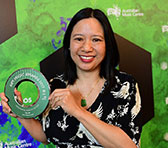
The AMC launches Echo (BETA), a new online learning platform, developed by the AMC, offering new perspectives through the Centre's living collection of scores, recordings, education resources and aggregated media.
SOUNDS AUSTRALIA and the Australian Music Centre provide a platform for Australian delegates at two important industry events in Europe: Jazzahead in Bremen in April, and Classical:NEXT in Rotterdam in May 2018.
2018 Art Music Awards winners include Robyn Holmes (for Distinguished Services to Australian Music). Other projects with AMC involvement include the 3rd round of the APRA Art Music Fund and the Summers Night Project, among others.


The AMPlify ICI pilot makes way for a new program entitled Ngarra-Burria: First Peoples Composers, delivered by a partnership between Moogahlin Performing Arts, the AMC, ANU School of Music, Ensemble Offspring and the Royal Australian Navy Band, with funding support from APRA AMCOS, and in-kind support from EORA College of TAFE. The logo for the program is designed by Ella English. Read an article by program participant Nardi Simpson.
The AMC secures funding from the Australia Council for the Arts for a two-year European market development project. Realised in partnership with SOUNDS AUSTRALIA, the project will create opportunities for Australian jazz in Europe. A news article on Resonate
A historic occasion on 22 October brings together two important events in Australian art music: the annual Peggy Glanville-Hicks Address, presented by Deborah Cheetham, now for the first time under the AMC's custodianship, and the prestigious Paul Lowin Prizes with winners Katy Abbott and Nigel Westlake.

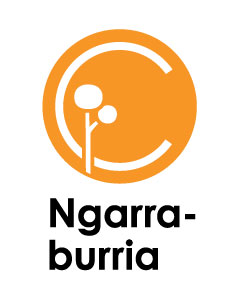
In the pandemic year, the AMC initiates a series of Peggy Glanville-Hicks Commissions and three rounds of MOMENTUM commissions supported by private philanthropists and companies. The 2020 Art Music Awards are celebrated virtually, and two Peggy Glanville-Hicks Addresses are presented online by Madeleine Flynn & Tim Humphrey, and by Sunny Kim.
The AMC now represents over 750 Australian composers and sound artists, with funding support for the next 4 years (2021-2024) confirmed by the Australia Council for the Arts.
We'd like to acknowledge the valuable support of the AMC's sponsors, partners and donors - see also the detailed list of our individual donors.
You can support the AMC's work by donating or by becoming a member.


Sources
AMC's archives, including photo archives, press cuttings, board reports, AMC's newsletters and journals.
Bebbington, Warren (ed.) 1997, The Oxford Companion to Australian Music, Oxford University Press, Melbourne.
Murdoch, James 2002 Peggy Glanville-Hicks: A Transposed Life, Pendragon Press, New York.
© Anni Heino / Australian Music Centre (2015-2020)


